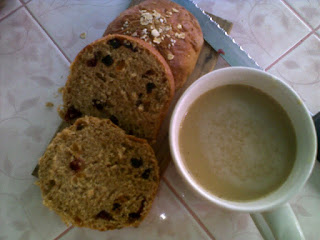This bun is something i invented to satisfy my carb craving every once in a while. I bake breads yes, but i don't really eat that much so it surprises my students to see me lean after all that baking. Still, since this is what i do for a living and what makes me happy (yeah, i bake for others so???) i thought of baking something that i can eat and share at the same time.
I used 10% whole wheat, used 1% molasses for color, 12% dark brown sugar, no margarine and since i am after flavor i used butter but at a very low 10% only. I used a sponge to increase the moisture and make this bread tender in the end, added 5% oats for more fiber and that was it. A somewhat lean dough with a slight bit of sweetness to it. Breads in Manila are at about 18-20% sweet, so this one is a good compromise.
For more biting experience, meaning para mas masarap nguyain, i added nuts and dried fruits after the mixing is done. Scaled them to 60 grams each just like the Soft Buns, and rounded each off. I slightly overproofed the dough to make them flatter, and also because this is what my sister likes, not the chewy version. We brought this bread once we went to Baguio and it has been a specialty bread since, perfect for baon to long trips.
See photos of the process below and i hope you will have the same inspiration to create breads that suit your mood and style the way i do.
So it started from this to......
This! and... make-up time below follows,
Hmm, make sure you grease those pans properly or else,,,
If you read my blog, you should know by now that i immediately drizzle the topping after i glaze the tops because....Another quiz, for you baking enthusiasts. Why did i use an eggwhite glaze as opposed to an eggwash made of whole eggs on this one? Anyone?
Why spray the top with water? I want the oats to stick more and to prevent the dough from drying in open air.
My favorite way to eat it, split in half, toast to crunchy side and sit in front of the tv.
www.breadmakinglessons.com
For starters i cannot make this Hard Monay if i did not bring any 3rd class flour or soft weak flour to New York. Once i ran out of 3rd class and tried Cake Flour, it turned bad, do not even think of using All Purpose, it will be soft but not chewy as this one made with yes, 3rd class indeed. So third class is hard to find here in the US if you will use that term. You have to say or look for soft wheat flour, that's it, not hard wheat flour, not cake or All purpose but something in between these two. It is easy to find in the Phil., just ask your local bakery suppliers and they know it is Tercera. Tercera is not for bread, bakers use it basically for cookies, cakes and other pastries, but we bakers know how to create bread recipes using part of this flour with the bread flour or hard wheat flour. It makes a softer version of any of your fave breads, with a cheaper price tag. Plus if i own a bakery, i get to use the third class for my cakes and cookies, lowering my food cos...














Comments